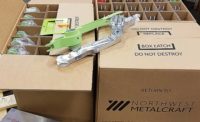When Ken Turzinski, president of TYRI Americas in Stevens Point, WI, returned from a local trade show a few years ago, he came back with a small, innocuous plastic product. Little did he know that the product would help his company become more lean and sustainable.
TYRI manufactures LED and halogen lighting for heavy vehicles. The company’s products can be seen on mining, forestry, construction, agriculture and material handling equipment. Its customers include major OEMs such as Deere, Jeep, BELAZ and Massey Ferguson.
The plastic product Turzinski returned with was a Box Latch from Box Latch Products in Pewaukee, WI. Made of durable recyclable plastic, Box Latches slide easily onto box flaps to keep them secure, so manufacturers can reuse the boxes and latches indefinitely. The latch is applied to one side of the box (top or bottom) without or with anchors. Boxes closed with the latch stack easily, and a label can be affixed on the latch. Large latches are available for use with one or two anchors. A small latch weighs half as much as a large one.
Workers slide the latches off to open the boxes. Each latch is strong enough to keep a 40-pound box of nuts and bolts closed when turned upside down. Tape is not needed.
The product reduces the need for tape, minimizes the need for tape guns and the time to refill them; eliminates injuries from box cutters; avoids damage to box contents from blades; and promotes the reuse of boxes undamaged by tape.
The use of Box Latches became part of a massive lean manufacturing makeover at TYRI. The first application where the company tried them was first-in, first-out (FIFO) inventory management. Like many businesses, TYRI stores several thousand boxes that need to be opened and closed as workers pick parts to assemble the company’s various products. A persistent problem was that multiple boxes containing the same parts were open at the same time, making it difficult to keep track of inventory.
Boxes from downstream suppliers with the same ID number were stored in racks. Once opened, staff either folded corners, taped tops shut, or left them open. When the boxes were left open, it reduced storage space and allowed for contamination.
Now, the first time a box is opened, workers close it with a neon green Large Box Latch. Why neon green? Because it shows up no matter how much light is present. Now, there’s no duplication of open boxes, no tape, no box destruction, no contamination, no damage to contents, instant recognition of the next box on the shelf from which to pick parts, and easy inventorying.
TYRI found Box Latches to be so useful that, when Box Latch introduced a new product, the Clip-and-Stack, TYRI put it to use immediately. Clip-and-Stacks keep box flaps open and allow for quick and easy loading and unloading.
Box flaps are perpetual obstacles to efficiency at assembly cells, notes Turzinski. The open flaps pose work flow impediments and cause ergonomic injuries for workers of short stature. The TYRI team quickly learned that one Clip-and-Stack holds two flaps down and out of the way while two retain all four. On a busy shop floor in tight workspaces, the clips make life easier and reduce task time.
For more information on clips and latches that enable tape-free closing of cardboard boxes, visit www.boxlatch.com.







